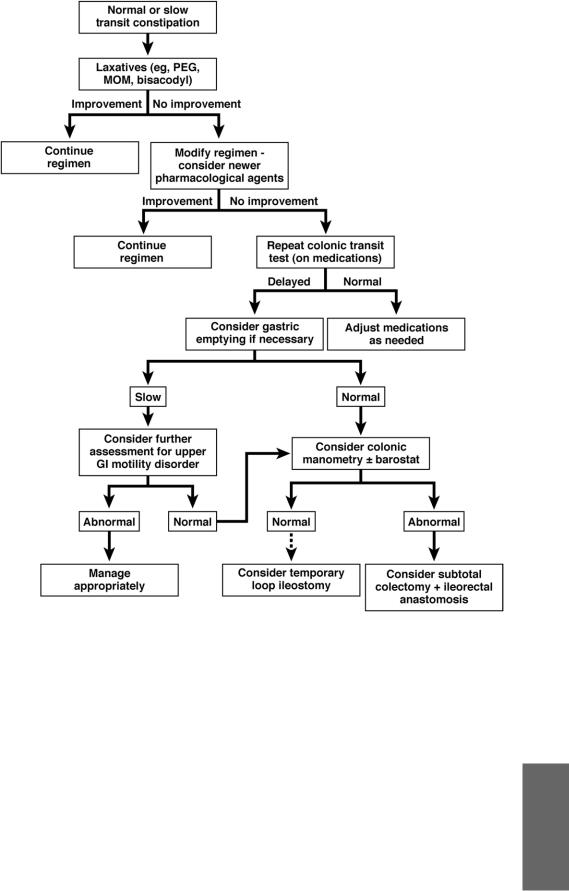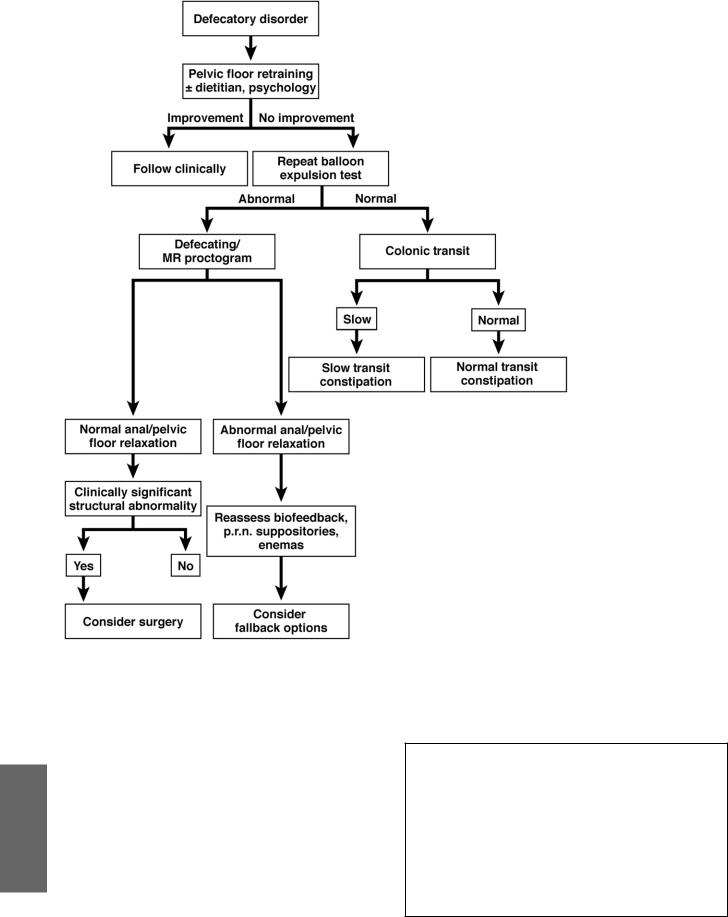
- •Clinical Subgroups
- •Defecatory Disorders
- •Combination Disorders
- •Clinical Evaluation
- •Clinical Assessment of Constipation
- •Diagnostic Tests
- •What Tests Should Be Performed to Assess for Medical Causes of Constipation?
- •Medical Management
- •Pelvic Floor Retraining
- •What Is the Initial Treatment Approach for Constipation?
- •Surgical Treatment of Constipation
- •What Approaches Should Be Considered for Constipation Unresponsive to Initial Approaches?
- •Acknowledgments
- •Reference

January 2013 |
AGA 215 |
Figure 2. Treatment algorithm for NTC and STC. PEG, polyethylene glycol; MOM, milk of magnesia; GI, gastrointestinal.
Medical Management
Figures 2 and 3 show treatments for the clinical subgroups.
We suggest a gradual increase in fiber intake, as both foods included in the diet and as supplements and/or an inexpensive osmotic agent, such as milk of magnesia or polyethylene glycol. Depending on stool consistency, the next step may be to supplement the osmotic agent with a stimulant laxative (eg, bisacodyl or glycerol suppositories), which is preferably administered 30 minutes after a meal to synergize the pharmacologic agent with the gastrocolonic response. For all of these agents (polyethylene glycol 17 g daily, milk of magnesia 1 oz twice daily, psyllium 15 g daily, glycerin or bisacodyl suppositories), the approximate daily cost is $1 or less.
A newer agent should be considered when symptoms do
not respond to laxatives. Two such drugs are lubiprostone and linaclotide whose daily costs at the time this guideline was developed were $7-$9. Another agent, prucalopride, is not available in the United States but has been approved in other countries.
Biofeedback therapy improves symptoms in more than 70% of patients with defecatory disorders. The motivation of the patient and therapist, the frequency and intensity of the retraining program, and the involvement of behavioral psychologists and dietitians as necessary all likely contribute to the chances of success. The schedule of therapy can be tailored to patients’ symptoms and varies among centers.
Patients who do not respond to standard approaches may require colonic manometry and barostat testing, which is only available at selected centers. Figure 3 shows the algorithm for defecatory disorder.
AGA

216 AGA |
GASTROENTEROLOGY Vol. 144, No. 1 |
AGA
Pelvic Floor Retraining
Biofeedback and relaxation training have been quite successful and, importantly, free of morbidity. Biofeedback can be used to train patients to relax their pelvic
floor muscles during straining and to correlate relaxation and pushing to achieve defecation. By the relearning process, the nonrelaxing pelvic floor is gradually suppressed and normal coordination restored. Biofeedback is also used in the treatment of fecal incontinence. There are, however, major differences between the approaches to fecal incontinence and constipation. Biofeedback has been shown to improve rectoanal coordination during defecation and symptoms of constipation despite reduced laxative use.
Figure 3. Treatment algorithm for defecating disorders. MR, magnetic resonance; p.r.n., as needed.
What Is the Initial Treatment Approach for Constipation?
After discontinuing medications that can cause constipation and performing blood and other tests as guided by clinical features, a therapeutic trial (ie, fiber supplementation and/or osmotic or stimulant laxatives) is recommended before anorectal testing (strong recommendation, moderate-quality evidence).
NTC and STC can be safely managed with long-term use of laxatives (strong recommendation, moderatequality evidence).
